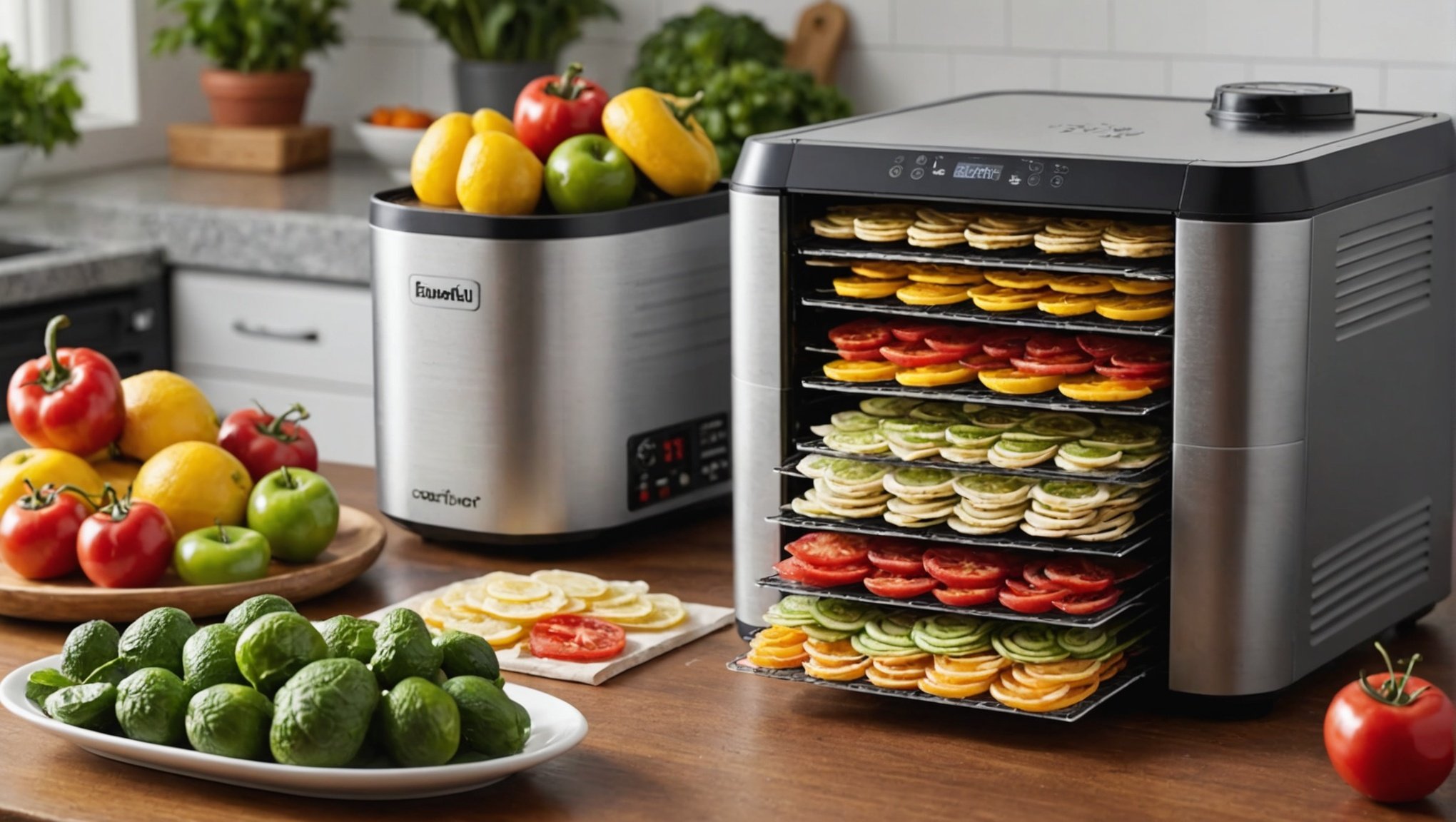Choosing a food dehydrator can seem overwhelming with countless options available. However, this essential kitchen tool empowers you to preserve both the flavor and nutrients of your favorite ingredients, promoting a healthier lifestyle. Understanding key features, types, and uses will help you make an informed decision. Get ready to elevate your culinary skills and enjoy tasty snacks that retain their natural goodness!
Comprehensive Buying Guide for Food Dehydrators
When embarking on the journey to purchase a food dehydrator, understanding essential features is crucial. The market offers various types, each catering to specific needs and uses. Let’s delve into what you should consider to make an informed decision.
Also to see : Top Child-Safe Kitchen Knife Choices in the UK: Ultimate Guide for Parents
Essential Features to Consider
- Temperature Control: A vital feature in any food dehydrator is adjustable temperature settings. This allows you to dehydrate different types of foods at their optimal temperatures, ensuring nutrient retention and preventing spoilage.
- Capacity and Size: Depending on your needs, consider the size of the dehydrator. Larger models are ideal for bulk processing, while smaller ones suit occasional use.
- Airflow and Heat Distribution: Efficient airflow and even heat distribution are critical for consistent results. Look for models with horizontal airflow for uniform drying.
Types of Food Dehydrators
- Stackable Tray Dehydrators: These models are compact and suitable for small batches. They are often more affordable and space-efficient, making them ideal for beginners.
- Shelf Dehydrators: Known for their even drying, shelf dehydrators are perfect for serious enthusiasts. They offer more space and better airflow, ensuring high-quality results.
Key Specifications Affecting Performance
- Wattage: Higher wattage generally means faster drying times but can increase energy consumption. Balance efficiency with energy use based on your drying needs.
- Noise Level: Some dehydrators can be noisy. If you plan to run the machine overnight, consider models with quieter operation.
Selecting the right food dehydrator involves evaluating these features and specifications to match your specific needs. By focusing on these key aspects, you can ensure a successful and satisfying dehydrating experience.
Benefits of Using a Food Dehydrator
Using a food dehydrator offers several advantages that can transform your culinary experience. One of the primary benefits of food dehydrators is their ability to preserve nutrients. Dehydration helps retain essential vitamins and minerals, which are often lost during other food preservation methods like canning or freezing. This process ensures that you enjoy healthy, nutrient-rich snacks and meals.
Have you seen this : Top Child-Safe Kitchen Knife Choices in the UK: Ultimate Guide for Parents
Another significant benefit is the potential for cost savings and reducing food waste. By dehydrating surplus produce, you can extend its shelf life, minimizing spoilage and waste. This not only saves money but also contributes to a more sustainable lifestyle.
Food dehydrators are incredibly versatile, allowing you to preserve a wide variety of foods. From fruits and vegetables to meats and herbs, the possibilities are endless. This versatility means you can create homemade snacks, jerky, and even dried herbs for cooking, all from the comfort of your kitchen. Embracing these benefits can lead to healthier eating habits and a more efficient use of resources.
Comparison of Different Food Dehydrator Models
When choosing a food dehydrator, evaluating different models is essential to find one that suits your needs and budget. Here’s a detailed food dehydrator comparison to guide you through the top-rated models, budget-friendly options, and high-end features.
Top-rated Models Overview
Some of the most highly-rated food dehydrators are praised for their efficiency and durability. Models like the Excalibur 3926TB and Nesco FD-75A are renowned for their adjustable thermostats and reliable performance. These dehydrators offer excellent temperature control and consistent results, making them favourites among users who regularly dehydrate various foods.
Budget-friendly Options
For those seeking affordability, consider models like the Presto 06300 Dehydro or Hamilton Beach 32100A. These budget-friendly food dehydrators provide essential features without breaking the bank. They are perfect for beginners or occasional users who want to explore food dehydration without a significant investment. Despite their lower price, these models still deliver satisfactory results for basic dehydration needs.
High-end Features and Performance
High-end models such as the Tribest Sedona SD-P9150 and LEM Products 1153 offer advanced features like digital controls and dual fan technology. These premium food dehydrators are designed for enthusiasts who prioritize precision and efficiency. They provide superior airflow and heat distribution, ensuring even drying across all trays. Investing in these models can enhance your dehydrating experience, offering more versatility and convenience.
Tips for Effective Use of Food Dehydrators
To make the most of your food dehydrator, it’s essential to follow some key usage tips. These practices can enhance your drying experience and ensure high-quality results.
Best Practices for Preparing Food for Dehydration
Proper preparation is crucial for effective dehydration. Begin by washing and drying your produce thoroughly. Cut food into uniform slices to ensure even drying. For fruits, consider pre-treating with lemon juice or ascorbic acid to prevent browning. Blanching vegetables briefly can help preserve color and nutrients.
Optimizing Temperature and Drying Times
Understanding the optimal temperature settings for different foods is vital. Fruits typically require a lower temperature, around 135°F, while meats like jerky need higher temperatures, approximately 160°F, to ensure safe drying. Monitor drying times closely, as they can vary based on humidity and thickness of the slices. Rotating trays periodically can also promote even drying.
Techniques for Flavor Enhancement During Dehydration
Enhancing flavors during dehydration can elevate your culinary creations. Marinating meats before drying can infuse them with additional taste. For fruits, sprinkling a bit of cinnamon or nutmeg can create delightful snacks. Experiment with herbs and spices to discover unique flavor profiles that suit your palate.
Preservation Techniques with Food Dehydrators
Food dehydrators are invaluable tools for food preservation techniques, allowing you to extend the shelf life of various foods while retaining their essential nutrients. Understanding the step-by-step process for dehydrating different types of food is crucial for effective preservation.
Step-by-step Process for Dehydrating Foods
When dehydrating fruits, begin by washing and slicing them into uniform pieces. This ensures even drying. Pre-treat fruits prone to browning, such as apples, with lemon juice. Arrange the slices on the dehydrator trays without overlapping. Set the temperature to around 135°F and monitor the drying process, which can take several hours depending on the fruit’s water content.
For vegetables, blanch them briefly before dehydration to preserve their color and nutrients. Slice them uniformly and place them on the trays. Dehydrate at a temperature of 125°F to 135°F. Check periodically to ensure they reach the desired crispness.
Dehydrating meats requires a higher temperature, typically around 160°F, to ensure safety. Slice meats thinly and marinate them for added flavor. Arrange the slices in a single layer on the trays. This process can take up to 10 hours, depending on the thickness and type of meat.
Understanding Moisture Levels and Storage
Understanding the importance of moisture levels is essential in food preservation techniques. Foods should be dried until they have about 10% moisture content, preventing spoilage and extending shelf life. Store dehydrated foods in airtight containers or vacuum-sealed bags to maintain their quality. Keep them in a cool, dark place to prevent moisture absorption and preserve their flavor and nutrients.
Innovative Recipes for Utilizing Dehydrated Foods
Dehydrated foods offer a canvas for creativity in the kitchen. Use dehydrated fruits in granola mixes, trail snacks, or as toppings for yogurt and cereal. Dehydrated vegetables can be rehydrated and added to soups, stews, or casseroles. They also make excellent additions to homemade spice blends. Experiment with dehydrated meats by incorporating them into jerky recipes or using them as protein-rich snacks. By exploring these innovative recipes, you can enjoy the benefits of food preservation techniques while diversifying your meals.
Maintenance and Troubleshooting Tips
Proper food dehydrator maintenance is essential for ensuring its longevity and optimal performance. Regular cleaning and upkeep not only extend the life of your dehydrator but also ensure that it operates efficiently. Begin by unplugging the appliance and allowing it to cool completely before cleaning. Remove trays and wash them with warm, soapy water. It’s important to dry them thoroughly to prevent any moisture accumulation, which could lead to mold.
For the base and heating elements, use a damp cloth to wipe away any residue or food particles. Avoid submerging these parts in water to prevent damage. Regularly check the fan and vents for blockages, as these can impede airflow and affect drying efficiency.
Common issues with dehydrators include uneven drying and overheating. Uneven drying can often be resolved by rotating trays during the process or ensuring the food is sliced uniformly. Overheating might be a sign of a malfunctioning thermostat, which may require professional repair or replacement.
To ensure your dehydrator continues to perform optimally, conduct routine checks on its electrical components. Inspect cords and plugs for signs of wear or damage. Keeping your dehydrator in a cool, dry place when not in use can also help maintain its condition. By following these maintenance and troubleshooting tips, you can enjoy consistent results and prolong the life of your food dehydrator.












